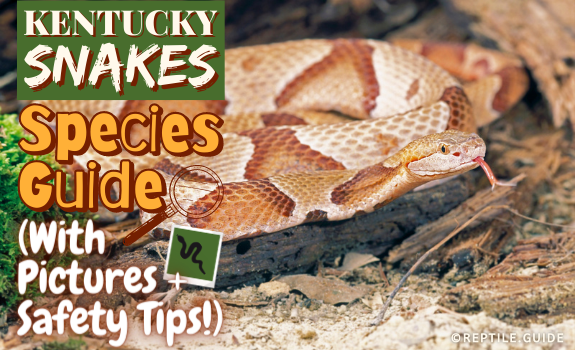You’ll find a diverse assortment of snakes in Kentucky. From slender ribbon snakes to stout copperheads, this state boasts 32 different species of snakes.
I’ll cover how to identify the most common, most dangerous, and most iconic snakes in the Bluegrass State.
You’ll find individual species profiles, including Kentucky snakes pictures and facts.
Read through to the end for a list of useful resources and recommendations on how to coexist with these captivating animals.
In This Article
In Short
The biggest takeaways from this guide are:
- Kentucky has 32 species of snakes.
- If you see a snake in the wild, it’s best to leave it alone.
- Most snake bites result from people attempting to handle or harm a snake in some way.
- There are only four species of venomous snakes in Kentucky, all of which are pit vipers.
- Snakes are more beneficial than they are harmful and are an essential component of the Kentucky ecosystem.
Snake Identification Basics
The most important components to consider when identifying a snake are:
- Size – Kentucky snakes range in size from seven inches to over six feet. Documenting the length of the snake you found can help set it apart from similar species.
- Color and Pattern – A snake’s pattern and coloration can be some of your most useful identification tools. Some snakes are solid colored, while others have distinct patterns and markings. You definitely won’t mistake species like the scarlet snake or rough greensnake for rattlesnakes in Kentucky. However, some species appear similar and are easy to misinterpret.
- Habitat and Location – Most snakes have certain geographic region restrictions and habitat preferences.
- Pupil and Head Shape – All four venomous species in the state have elliptical pupils and broad, triangular heads. The non-venomous snakes have round pupils and varying head shapes that are generally the same width as their bodies.
For example, if you find a brown snake in Kentucky, it could be many of the species within the state.
You’re much more likely to reach a correct identification when also considering the length, head, pupil shape, and where you found the snake.
Quickly Identifying Venomous Snakes in Kentucky
There are only four venomous, often mislabeled as poisonous, snakes in Kentucky. All four species are pit vipers belonging to the Viperidae family.
Identifying these species is fairly straightforward due to their shared traits.
You can recognize pit vipers by their:
- Elliptical Pupils – Vertical pupils, like cat eyes
- Triangular Heads – Broad, triangular heads accommodating venom glands behind the jaw
- Heat-Sensing Pits – Deep sensory pits between each eye and nostril help the snake locate prey
- A Single Row of Scales Under the Tail – Most harmless species in the state have two rows of scales on the underside of the tail, behind the cloaca.
Although these features are excellent identifiers, many snakes have evolved to look or act like deadly vipers.
You’re also most likely to see these characteristics at close-range, which could present a dangerous situation.
Always proceed with caution if you aren’t 100% certain of a snake’s identity.
Copperhead
The copperhead is the most common venomous snake species in Kentucky.
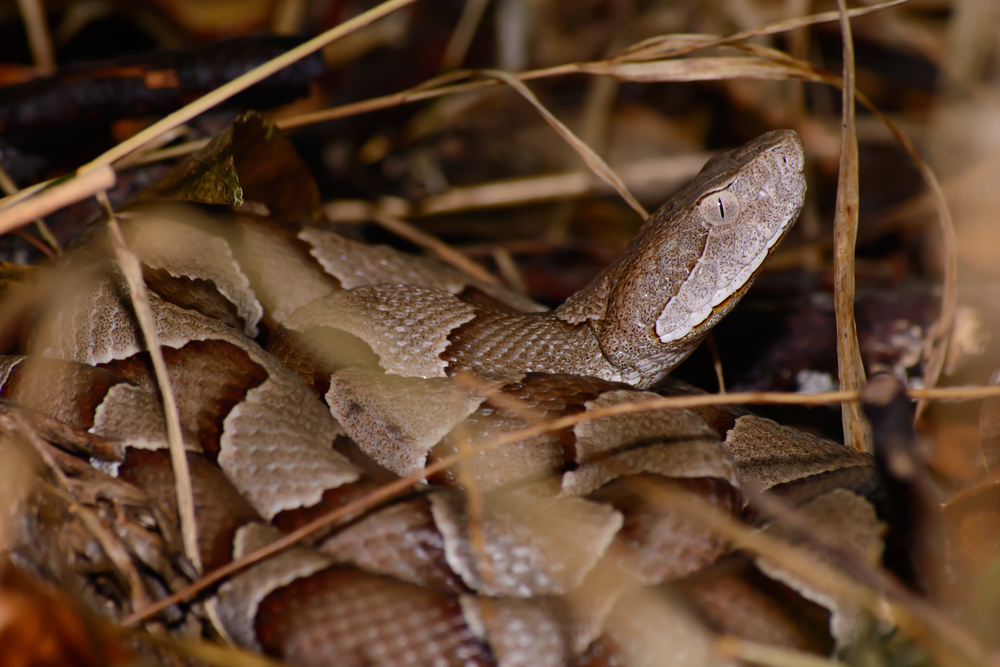
| Scientific Name: | Agkistrodon contortrix |
|---|---|
| Range: | Statewide |
| Adult Size: | 20-37 inches
May reach four feet |
| Description: | Elliptical pupils and sensory pits on a blocky head
Heavy-bodied with keeled scales Copper-red or brown with chestnut, hour-glass shaped bands, and a distinct copper-colored head May have dark spots between bands Juveniles have yellow-green tail tips that fade as they age |
| Habitat: | Rocky, wooded hillsides and lowland areas |
| Diet: | Small mammals, frogs, insects, lizards, and birds |
| Venomous/Non-venomous: | Venomous |
Western Cottonmouth
Also called water moccasin, the cottonmouth prefers habitats near sources of fresh water.
They are a “Species of Greatest Conservation Need” in Kentucky.
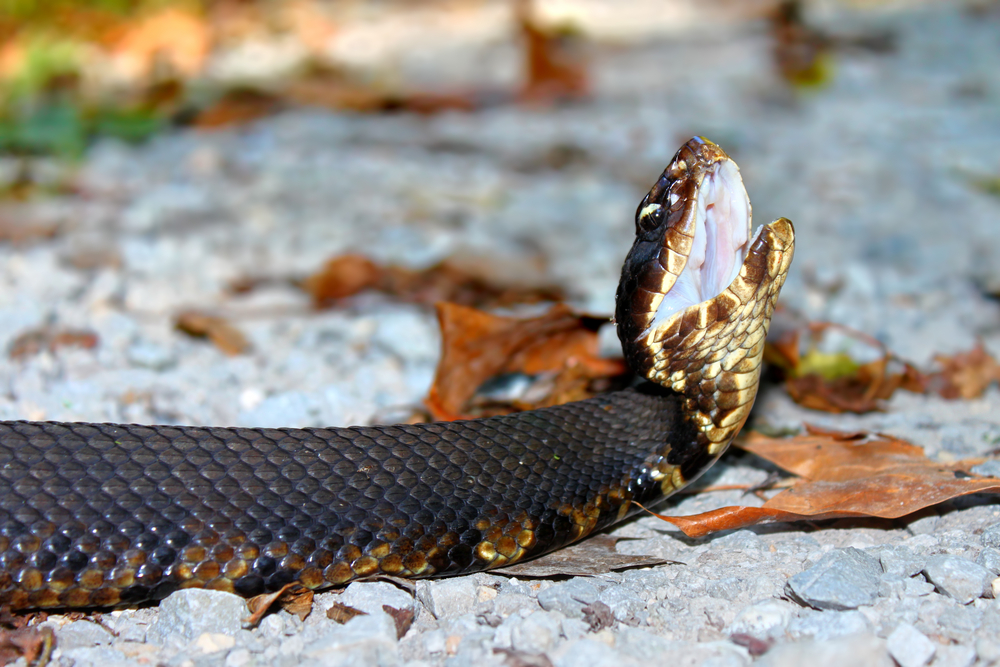
| Scientific Name: | Agkistrodon piscivorus |
|---|---|
| Range: | Western Kentucky |
| Adult Size: | Two to four feet |
| Description: | A heavy-bodied snake with keeled scales, a stocky head, facial pits, and elliptical pupils
Dark brown to black bodies with dark crossbands, but may appear patternless Juveniles have yellow-green tail tips and bold patterns that fade as they age |
| Habitat: | Habitats near water, such as swamps, lakes, wetlands, and floodplains, but may also be found in upland areas |
| Diet: | Fish, amphibians, small mammals, birds, and reptiles (including other snakes) |
| Venomous/Non-venomous: | Venomous |
Timber Rattlesnake
The timber rattlesnake is the largest of Kentucky’s deadly snakes.
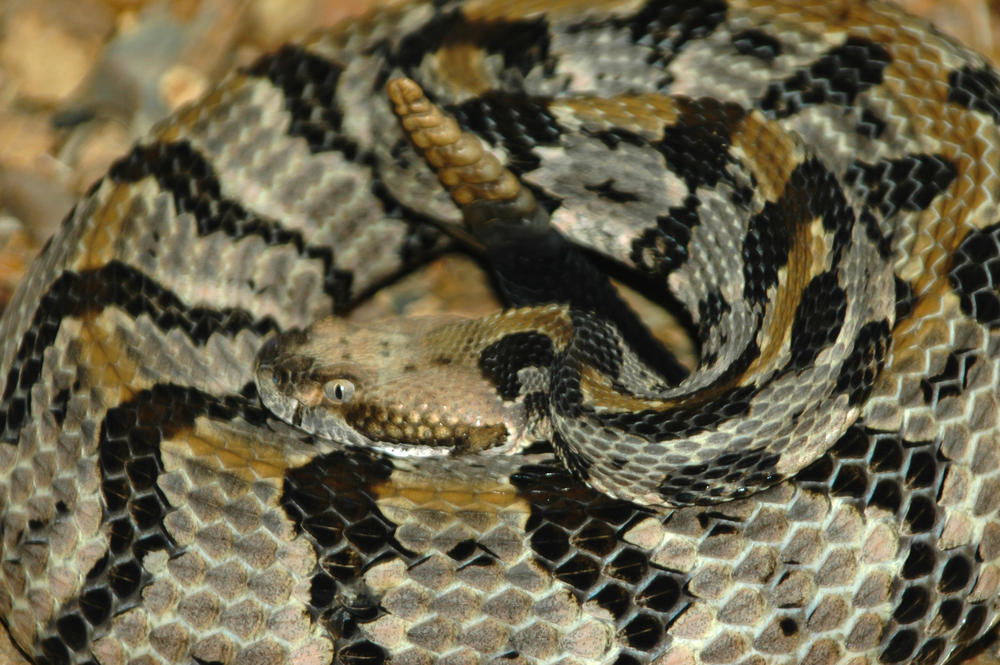
| Scientific Name: | Crotalus horridus |
|---|---|
| Range: | Statewide except for the Inner Bluegrass Region and Northern Kentucky |
| Adult Size: | 2.5-3.5 feet, up to five feet |
| Description: | Stout body, keeled scales, elliptical pupils, facial pits, and a distinctive rattle at the end of the tail
Gray, yellow, brown, or green with dark V-shaped crossbands, some individuals appear completely black |
| Habitat: | Heavily forested areas, rocky outcrops, and bluffs, especially South and Southwest facing hillsides |
| Diet: | Small mammals, mostly rodents |
| Venomous/Non-venomous: | Venomous |
Pygmy Rattlesnake
The pygmy, or pigmy, rattlesnake is the smallest pit viper in Kentucky.
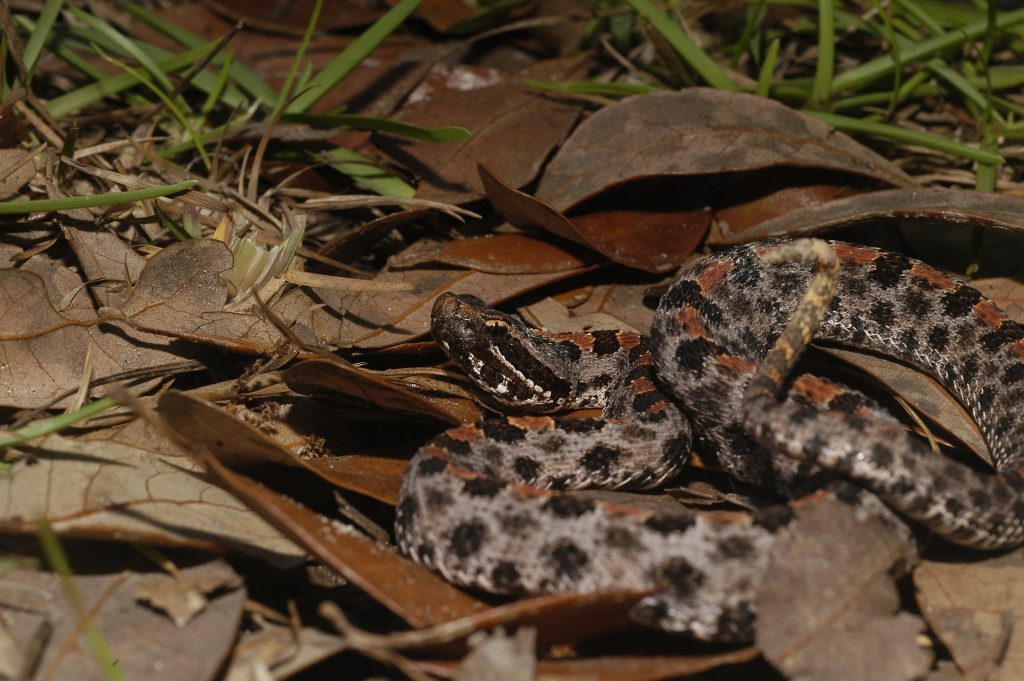
Image credit: FunkyHumanBeing (via creativecommons.org)
| Scientific Name: | Sistrurus miliarius |
|---|---|
| Range: | Only found in Calloway, Lyon, and Trigg counties |
| Adult Size: | 12-25 inches |
| Description: | Keeled scales, elliptical pupils, and sensory pits
Gray or brown body, dark spots along the back and sides, and a dark bar from each eye to the jaw May have a rust-colored dorsal stripe |
| Habitat: | We know little about their habitat preferences within Kentucky, but pygmy rattlesnakes, in general, prefer forested areas near water |
| Diet: | Small mammals, reptiles, frogs, and centipedes |
| Venomous/Non-venomous: | Venomous |
Most Common Snakes in Kentucky
According to sites like iNaturalist, you’re most likely to find these types of snakes in Kentucky (in order from most common to least common):
- Common garter snake
- Gray rat snake
- Eastern copperhead
- Common watersnake
- Ring-necked snake
- North American racer
Garter Snakes
There are three species of garter snakes in Kentucky. You’re most likely to encounter the common garter snake.
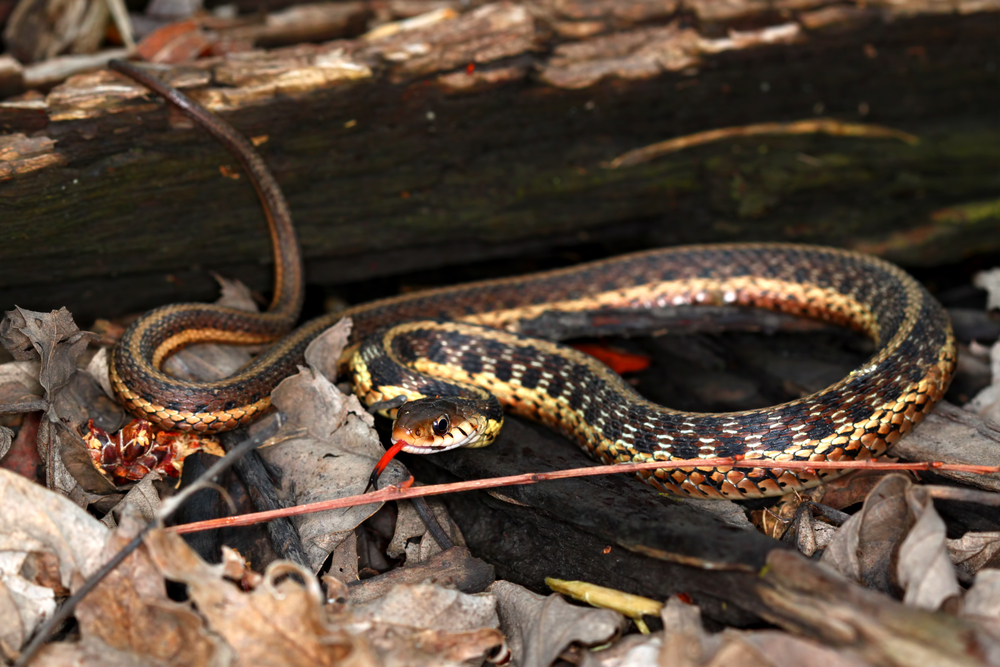
| Scientific Name: | Thamnophis sirtalis
Eastern garter snake: Thamnophis s. sirtalis |
|---|---|
| Range: | Statewide |
| Adult Size: | 18-26 inches |
| Description: | Round pupils and keeled scales on a slender body
Coloration varies, but most are brown or black with three light-colored stripes along the body Dark bars on the lip scales help distinguish the common garter snake from its relatives, the ribbonsnakes |
| Habitat: | Habitat generalists, including woodlands, farms, wetlands, and urban areas
Especially common near sources of fresh water |
| Diet: | Amphibians, mice, insects, and birds |
| Venomous/Non-venomous: | Non-venomous |
Rat Snakes
If you hear of a cow snake or chicken snake, it may be a gray rat snake in Kentucky. These nicknames come from its preference for consuming small rodents, birds, and bird eggs.
Some farmers utilize rat snakes as pest control around their barns.
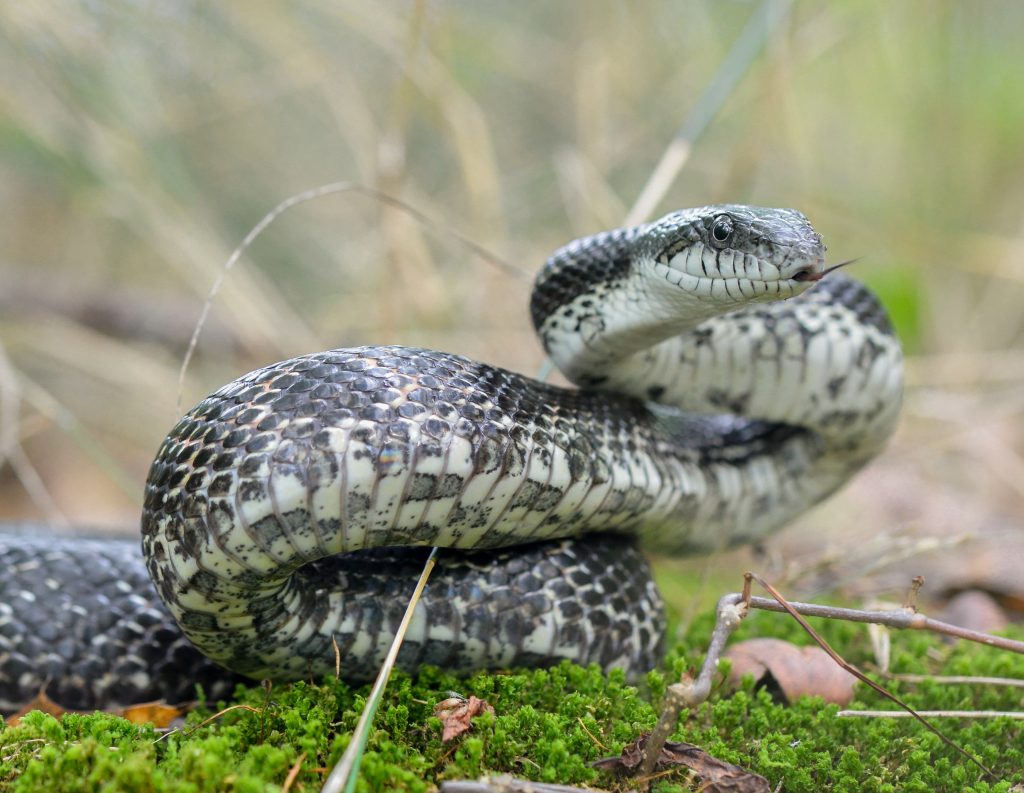
Image credit: Will Brown (via creativecommons.org)
| Scientific Name: | Pantherophis spiloides |
|---|---|
| Range: | Statewide |
| Adult Size: | 42-72 inches |
| Description: | Round pupils and weakly keeled scales
Black or gray bodies with dark blotches |
| Habitat: | A variety of habitats, including woodlands, farms, and suburban areas
They’re good climbers, often seen in trees |
| Diet: | Small mammals, birds, and eggs |
| Venomous/Non-venomous: | Non-venomous |
The gray rat snake is one of several Pantherophis species that was once considered a subspecies of black rat snake.
After an update to their taxonomy, they’re now classified as individual species.
Water Snakes
There are five species of water snakes in Kentucky. The common watersnake, or Northern water snake, is the most abundant in the state.
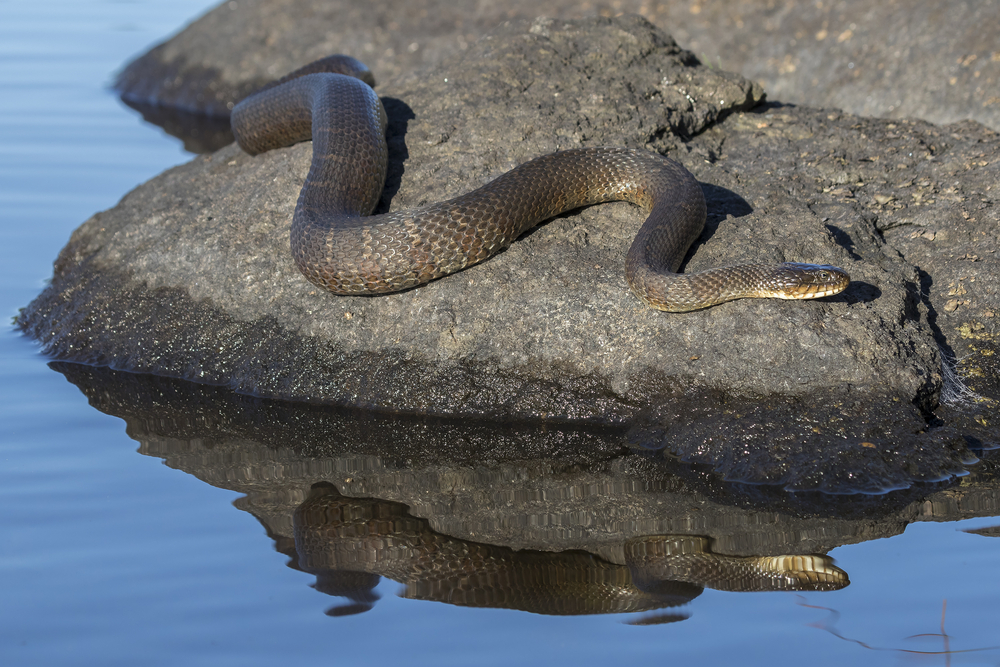
| Scientific Name: | Nerodia sipedon |
|---|---|
| Range: | Statewide |
| Adult Size: | 22-42 inches |
| Description: | Heavy-bodied with keeled scales and round pupils
Brown, gray, or black with brown or reddish-brown markings along the body Older adults may appear patternless |
| Habitat: | Habitats in or near sources of fresh water |
| Diet: | Fish, amphibians, and insects |
| Venomous/Non-venomous: | Non-venomous |
People often mistake watersnakes for cottonmouths because of their shared habitat preferences and similar appearances. However, there are several ways to tell them apart:
- Watersnakes have round pupils and lack facial pits.
- When intimidated, cottonmouths vibrate their tails; watersnakes don’t.
- Watersnakes swim with their heads at the water’s surface. A cottonmouth typically swims with its head sticking out of the water.
- A cottonmouth will “gape” when it feels threatened, showing the white lining of its mouth. It’s uncommon for watersnakes to exhibit this behavior.
Cottonmouths only live in Western Kentucky.
Ring-Necked Snakes
Look for these snakes hiding with their preferred diet of earthworms and snails under rocks, logs, and debris.
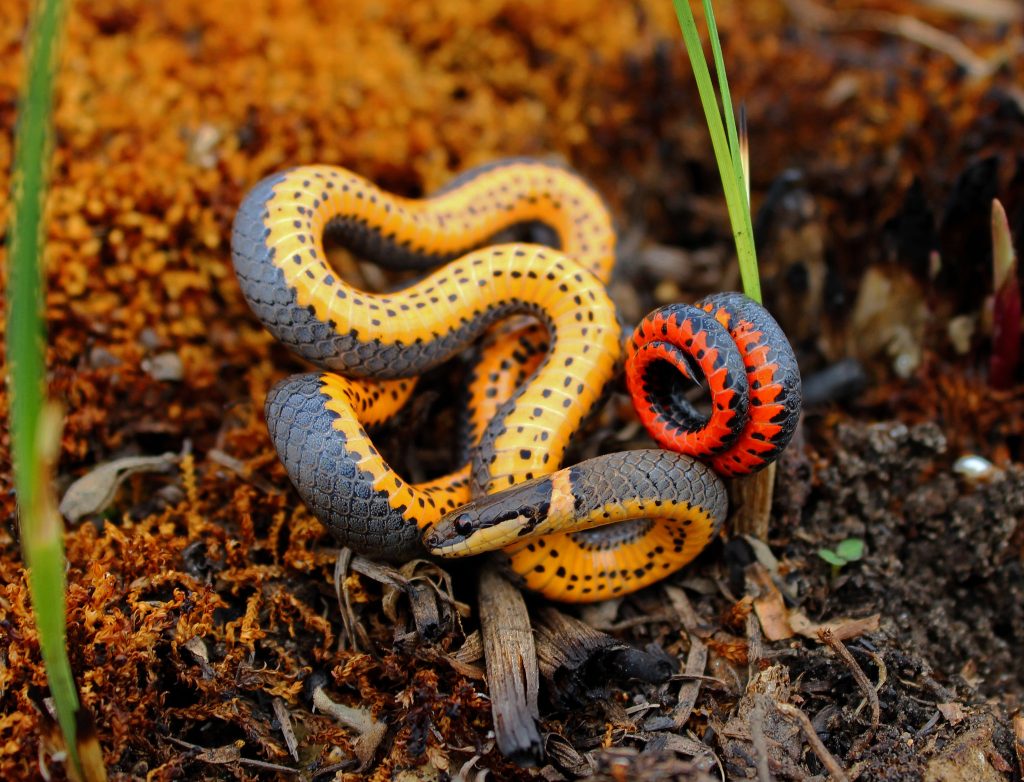
Image credit: 2ndPeter (via creativecommons.org)
| Scientific Name: | Diadophis punctatus |
|---|---|
| Range: | Statewide |
| Adult Size: | 10-18 inches |
| Description: | Slender-bodied snake with smooth scales and round pupils
Solid colored bodies; either gray, black, olive, or somewhere in-between Distinguishing yellow, orange, or red ventral scales and a ring around its neck |
| Habitat: | Forests and moist habitats |
| Diet: | Earthworms, slugs, snails, amphibians, and small reptiles |
| Venomous/Non-venomous: | Non-venomous |
Eastern Racers
These black snakes in Kentucky are difficult to keep up with. As their name suggests, racers are fast-moving.
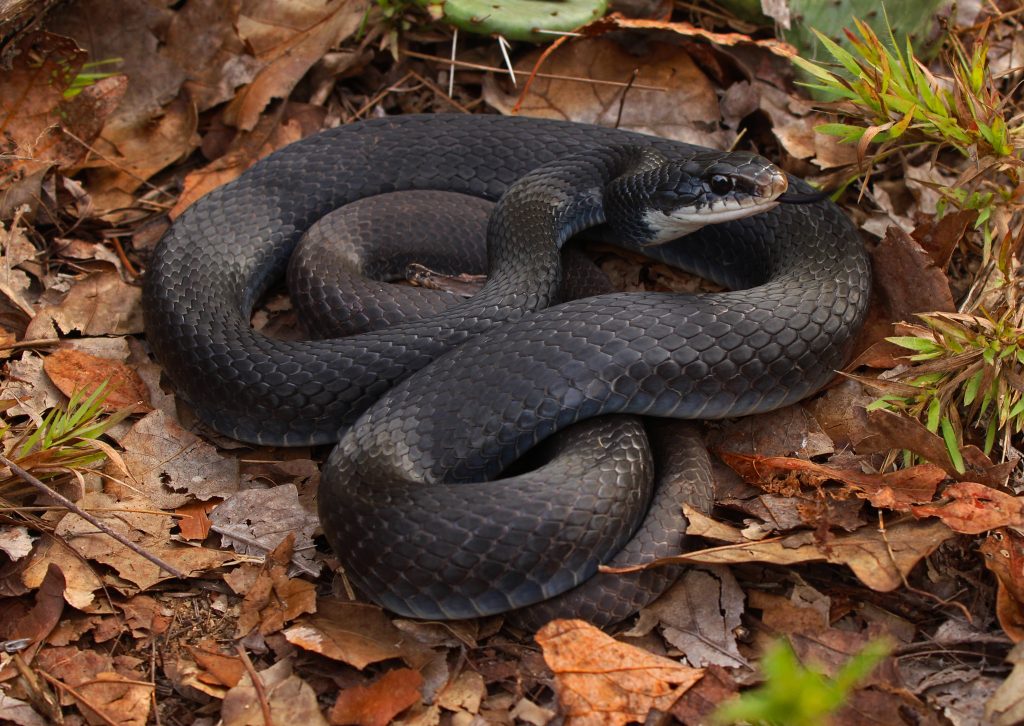
Image credit: 2ndPeter (via creativecommons.org)
| Scientific Name: | North American Black Racer – Coluber constrictor |
|---|---|
| Range: | Statewide |
| Adult Size: | 20-60 inches |
| Description: | Slender bodies with smooth, shiny scales and round pupils
Uniformly black or blue-gray with a white chin Juveniles have dark-colored blotches |
| Habitat: | A variety of habitats, with a preference for grasslands, forest edges, and near wetlands
Excellent climbers; often found in trees and shrubs |
| Diet: | Generalists, including rodents, birds, amphibians, insects, and reptiles, including snakes |
| Venomous/Non-venomous: | Non-venomous |
Iconic Snake Species
Snakes are unique, variable animals. Some species are especially remarkable, standing out from the rest.
Let’s take a look at some of the most iconic species of Kentucky snakes.
Eastern Hognose Snake
The Eastern hognose, Heterodon platirhinos, is an unusual species with dramatic tendencies.
Hognose snakes have unique defensive displays. When threatened, a hognose widens its head and neck, inflates its body, and releases a long hiss.
If this isn’t enough to ward off a predator, the hognose will play dead. It rolls over, twitches, lets its tongue dangle from its open mouth, and emits a foul-smelling musk.
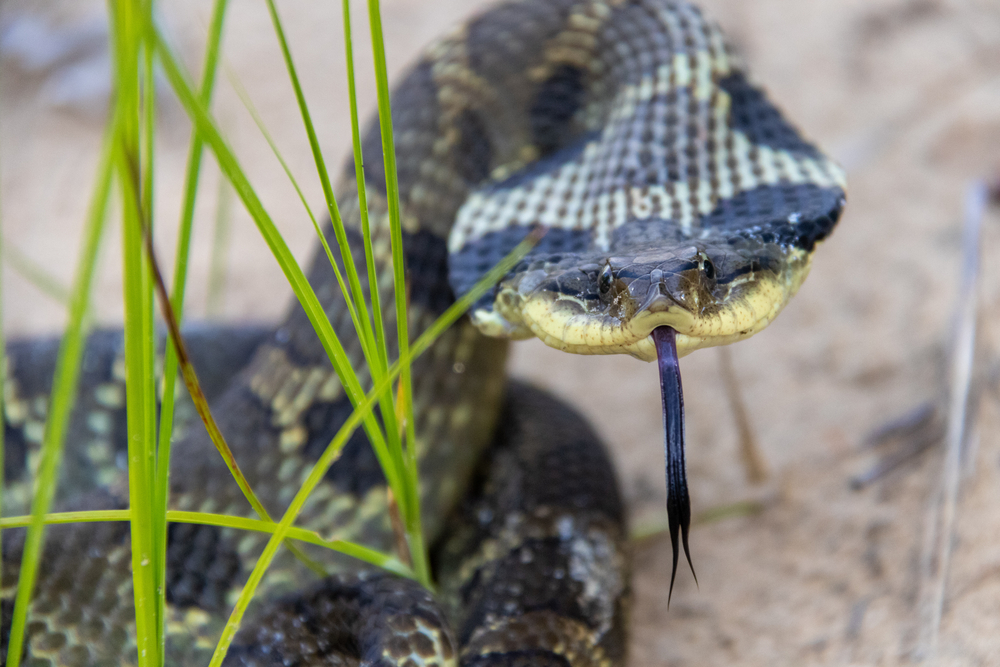
You’ll find these snakes in an assortment of habitats throughout Kentucky, but they prefer areas with sandy, loose soil.
Its upturned snout helps it burrow and dig for prey.
Scarlet Kingsnake
Although it isn’t one of the most common snakes in Kentucky, the scarlet kingsnake is memorable for its flashy pattern.
Many people easily and frequently misidentify these snakes as venomous coral snakes.
Their imitation of the coral snake’s pattern is called Batesian mimicry. The scarlet kingsnake tricks predators into thinking it’s venomous.
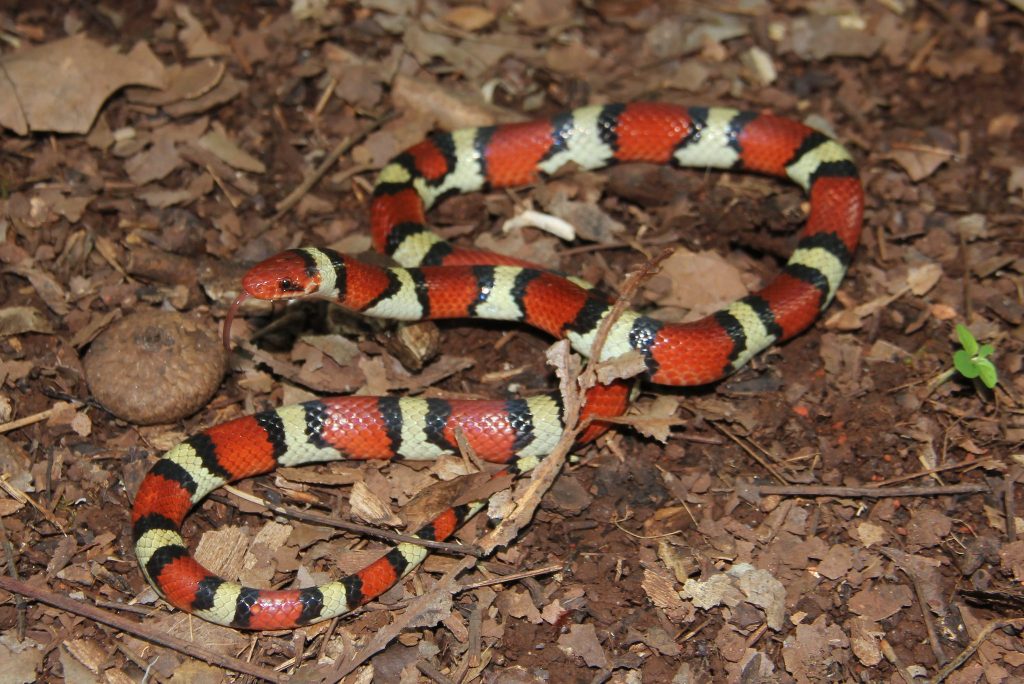
Image credit: LandBetweentheLakesKYTN (via creativecommons.org)
Don’t worry about remembering which is which, because coral snakes don’t live in Kentucky.
The scarlet kingsnake is deemed a Species of Greatest Conservation Need by the Kentucky Department of Fish and Wildlife Resources.
It only resides in extreme Southern, Eastern, and Western Kentucky.
Snakes Native to Kentucky
Below is a comprehensive list of Kentucky snakes, organized by family and genera.
Colubridae
All but four of the 32 snake species native to Kentucky belong to the family Colubridae.
The Colubrids are a family of non-venomous snakes found throughout the world. It’s the most extensive family of snakes, and the most diverse.
| Racers | |
|---|---|
| Eastern Racer | Coluber constrictor |
| Mud Snakes | |
| Red-bellied Mudsnake | Farancia abacura |
| Rat Snakes | |
| Gray Ratsnake | Pantherophis spiloides |
| Red Cornsnake | Pantherophis guttatus |
| Pine Snakes | |
| Northern Pinesnake | Pituophis melanoleucus |
| Kingsnakes | |
| Black Kingsnake | Lampropeltis nigra |
| Prairie Kingsnake | Lampropeltis calligaster |
| Scarlet Kingsnake | Lampropeltis elapsoides |
| Eastern Milksnake | Lampropeltis triangulum |
| Worm Snakes | |
| Common Wormsnake | Carphophis ameonus |
| Brown Snakes | |
| Dekay’s Brownsnake | Storeria dekayi |
| Red-bellied Snake | Storeria occipitomaculata |
| Earthsnakes | |
| Smooth Earthsnake | Virginia valeriae |
| Greensnakes | |
| Rough Greensnake | Opheodrys aestivus |
| Water Snakes | |
| Common Watersnake | Nerodia sipedon |
| Plainbelly Watersnake | Nerodia erythrogaster |
| Broad-banded Watersnake | Nerodia fasciata |
| Diamondback Watersnake | Nerodia rhombifer |
| Mississippi Green Watersnake | Nerodia cyclopion |
| Garter Snakes | |
| Eastern Garter Snake | Thamnophis sirtalis |
| Eastern Ribbon Snake | Thamnophis sauritus |
| Western Ribbon Snake | Thamnophis proximus |
| Scarlet Snakes | |
| Scarlet Snake | Cemophora coccinea |
| Hognose Snakes | |
| Eastern Hog-nosed Snake | Heterodon platirhinos |
| Crayfish Snakes | |
| Queensnake | Regina septemvittata |
| Centipede Snakes | |
| Southeastern Crowned Snake | Tantilla coronata |
| Kirtland’s Snake | |
| Kirtland’s Snake | Clonophis kirtlandii |
| Ring-necked Snakes | |
| Ring-necked Snake | Diadophis punctatus |
Viperidae
All four venomous Kentucky snakes belong to the Viperidae family.
| American Moccasins | |
|---|---|
| Copperhead | Agkistrodon contortrix |
| Cottonmouth | Agkistrodon piscivorus |
| Rattlesnakes | |
| Pygmy Rattlesnake | Sistrurus miliarius |
| Timber Rattlesnake | Crotalus horridus |
What You Need to Know
Snakes aren’t the scary beasts much of society has made them out to be. In fact, many snakes make excellent pets!
Most wild snakes are reclusive and prefer not to be around people. Coming across one in the wild is just as startling, if not more, for them as it is for you.
Other than accidentally stepping on or grabbing a snake, most bites occur when someone is purposefully trying to injure or handle a snake.
The best thing to do if you see a snake is to leave it alone.
Coexisting With Snakes
Snakes are essential elements of the Kentucky ecosystem.
They help keep pest populations balanced by consuming rodents, insects, and other invertebrates that cause damage to crops and spread disease.
Snakes help prevent the spread of disease by consuming sick animals or animals that host Lyme disease-carrying ticks.
They’re also an important food source for numerous animals, including mammals, birds, fish, and other reptiles.
Snakes do more good than harm, and we need to keep them around. The most suitable way to overcome a fear of snakes is by educating yourself.
Snake Safety
Venomous Snakes
You’re more likely to accidentally step on a pit viper than you are many of the harmless species in Kentucky.
Instead of running away when startled, they prefer to stay as still as possible and camouflage with their environment.
Don’t let this worry you too much; venomous snake bites are far and few between in the United States, and fatal bites are extremely rare.
Except for the copperhead, most of Kentucky’s dangerous snakes live in remote areas away from civilization. It’s unlikely that you’ll come across one.
If you see one of the state’s venomous species, respect its space, and you’ll stay safe.
Treading Carefully in Snake Habitat
There are a few simple steps to keep yourself and your loved ones safe around snakes.
The best measures to take while in potential snake habitats:
- Wear sturdy boots and long pants while hiking.
- Stay on marked paths that are well-worn or paved.
- Watch where you step, sit, and where you place your hands.
- Keep your pet on a leash and monitor where they put their noses.
Snakes commonly hide under rocks, wood, debris, and in vegetation.
If You Encounter a Snake
If you encounter a snake in the wild, stay calm.
Admire it from a distance and continue on your way, or let it leave on its own.
If the snake is in an area that poses a threat to you or it’s at risk, contact a professional wildlife handler to remove it.
Never attempt to capture or kill a snake.
When to Call for Help
Few situations warrant calling for help. The only times you’ll need professional assistance are if you or your loved ones are in danger.
If a venomous snake bites you, call 911 immediately.
Don’t wait for symptoms to appear. Antivenom is most effective when administered within a few hours.
Seek emergency veterinary care if a venomous snake bites your pet.
Utilize the resources below to find professionals in your area.
Useful Resources
Emergency Resources
- Free Snake Relocation Directory on Facebook
- Kentucky Fish and Wildlife Resources Nuisance Control Lookup
Pet Emergencies
- Pet Poison Hotline 800-213-6680
- ASPCA Animal Poison Control Center 888-426-4435
Educational Resources
- Department of Fish and Wildlife Resources E-book on Kentucky snakes
- The University of Kentucky’s Forestry Department webpage includes an easy to use snakes in Kentucky identifier
Articles Related to Kentucky Snake Identification
If you’re interested in articles similar to this KY snakes identification guide, you may like:
- Pennsylvania Snakes Identification Guide: All Species & Pics
- Arizona Snakes Identification Guide: Species Info & Pro Advice
- Michigan Snakes Species Guide: How to Identify Snakes & Keep Safe
Want to learn more about snakes? We have a myriad of detailed guides written by experts!
Is there something we missed that you’re dying to know about Kentucky snakes? Let us know in the comments!
